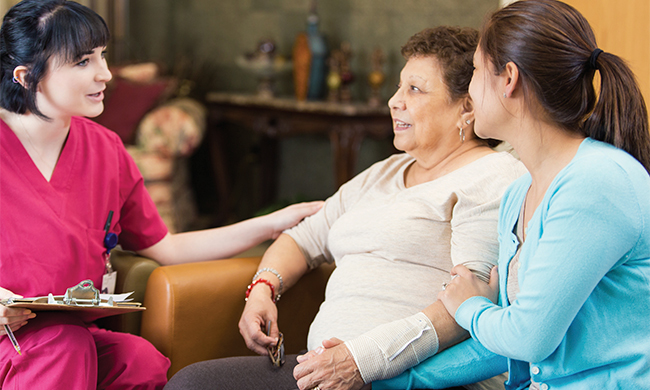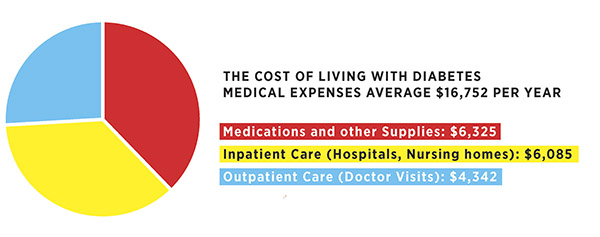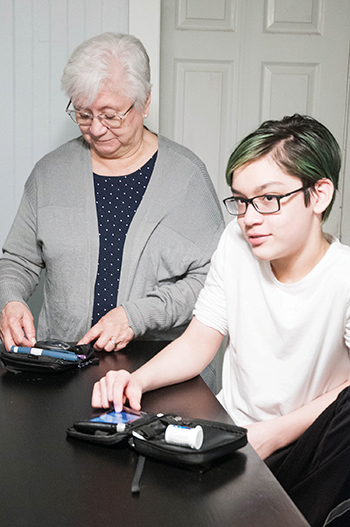HEALTHY LIVING
Build a better health care budget

(Family Features) Managing a chronic disease takes plenty of special planning and attention, and in many cases, a lot of money. In some cases, the expenses associated with disease management are overwhelming, forcing patients to skip essential treatments or medication and risk serious health complications.
One example is diabetes. A study published in the “Journal of American Medicine” found that 1 in 4 individuals with diabetes had rationed their insulin, which can impact short- and long-term health. Since 2002, the list price of insulin has risen, often costing customers without health insurance or on high-deductible insurance plans upwards of $1,000 for a one-month supply.

Consider these ideas to help manage the expense associated with a chronic disease:
1. Health Insurance
Whether you have a chronic condition or you’re generally healthy, it’s important to understand the different types of health insurance available to you. Commercial health plans can be purchased by anyone and may be available through your employer, or you may be eligible for government-funded health care, but there are numerous other options and variables to consider.
Understanding the costs associated with insurance plans means taking into account both your monthly premium and out-of-pocket costs like co-pays, co-insurance and deductibles. When choosing a plan, decide whether you’d rather pay a higher amount each month (premium) and less when you see the doctor (co-pays, co-insurance or deductible), or if you’d prefer to pay less each month and more when you need to see the doctor or fill prescriptions.
Another consideration is the plan’s network. There can be a significant budget impact when you see doctors in-network vs. out-of-network. Other potential cost-saving options include health savings accounts or flexible spending accounts, which might save you tax dollars.

2. Doctor Visits
Avoiding visits to the doctor because of the expense can end up costing more in the long run if you leave serious symptoms untreated or fail to properly manage a chronic condition. Make sure you understand all costs associated with your visits, including what’s covered by insurance, your co-pay and any out-of-pocket costs. Labs and tests aren’t always covered, and certain conditions like diabetes can require many test-related expenses. Sometimes saving money can be as simple as having lab work done at an in-network facility and sent to your doctor.
In addition to a primary care doctor, many patients with diabetes also see an endocrinologist and have more frequent visits to the eye doctor. Indirect costs like transportation and childcare may also impact the overall expense of a visit.
3. Prescription Drugs
Doing your research can make a major difference in what you pay for your prescriptions. For many conditions, such as diabetes, the cost of medication may make it tempting to skip doses to make a prescription last longer, but that can have dire medical consequences.
Instead, conduct price checks with various pharmacies and discuss your medication options with your doctor, including which of your prescriptions have generic alternatives available. If a generic is a possibility and your doctor believes it’s a good match for your condition, be sure the prescription notes that substituting is allowed. You can also look into coupon savings and patient assistance plans.
In addition, some programs are available to help people with certain conditions. For example, GetInsulin.org, created by nonprofit organization Beyond Type 1, is a one-stop tool for anyone with diabetes who is having trouble accessing affordable insulin in the United States.
“High-quality, modern insulin must be available to people with diabetes regardless of employment or insurance status, across all demographics, without barriers and at an affordable and predictable price point,” said Thom Scher, CEO of Beyond Type 1.
Through the website, users answer a few questions and receive customized action plans to guide them through the access solutions that best serve their unique circumstances such as location, insurance type, income and prescription.
4. Medical Equipment
Devices like oxygen tanks, pacemakers, blood glucose monitors and CPAP machines for sleep apnea play vital roles in treating serious medical conditions. If you’re worried about the cost of equipment recommended to help you navigate a short- or long-term diagnosis, work with your doctor and insurance company to figure out the most cost-effective method to achieve your treatment goals.
5. Emergency Care
A medical emergency isn’t only a drain on your physical and mental well-being, it can deliver a major blow to your finances. Emergency care can cost thousands of dollars per visit, especially with high-deductible insurance plans. Some conditions like diabetes are associated with a higher likelihood of emergency care needs for complications such as diabetic ketoacidosis and severe hypoglycemia. To offset the impact of potential emergency care expenses, plan ahead and build a savings account for your medical needs.
6. Food
Certain diets cost more to maintain, and that can be especially true when you’re eating to accommodate a medical need. When planning food costs, be sure to account for the foods you’ll eat regularly, as well as the extras you’ll need, such as glucose gummies and snacks to treat low blood sugar for those living with diabetes.

Searching for Solutions
After her father passed away from complications of uncontrolled diabetes, Christine Kanderski was determined to never relive that pain. This meant finding a way to afford treatment for her mother’s type 2 diabetes and her son’s type 1 diabetes.
“There was no way that my family and I were going to let diabetes take another one of our family members,” Kanderski said.
Kanderski budgeted for a laundry list of costs: appointments, health insurance, needles, test strips, glucose meters and insulin. One trick she found to save money was sharing supplies between her mother and son.
When things seemed hopeless, Kanderski reached out to the diabetes community for support and resources. Tools like GetInsulin.org can help people find affordable insulin. Users answer a few questions and receive customized action plans to guide them through solutions that best serve their unique circumstances.
Learn about options to help manage your diabetes-related expenses at GetInsulin.org .
Photos courtesy of Getty Images (Nurse and woman with patient, Doctor with patient)
Pie chart caption: According to research from the American Diabetes Association
SOURCE:
Beyond Type 1
HEALTHY LIVING
4 things parents, youth athletes should know about concussions

(Family Features) Despite the attention drawn to the topic of concussions over the past decade, it can be difficult to find readily available answers about what parents and young athletes should do after sustaining a concussion.
The Katsuyama family started 2023 without a single concussion, even with quite a few hockey and lacrosse seasons under its belt. That changed when Rylan, 11, received two concussions within five months from sports. One week after Rylan’s second concussion, his brother, Brandon, 13, was illegally checked from behind in a hockey game and sustained his first concussion. After clearing protocol in four weeks, he suffered a second concussion six weeks later.
Both boys endured months of headaches, missed school, dizziness, nausea and the added difficulty of navigating a significant injury peers and adults couldn’t see.
Their father, Brad Katsuyama, co-founder of IEX – a disruptive stock exchange featured in the best-selling book by Michael Lewis, “Flash Boys: A Wall Street Revolt” – sought out expert opinions to guide his family’s decisions and shares some acquired knowledge to help parents and athletes.
1. Brain injuries should be diagnosed by a concussion specialist.
There is no X-ray, MRI or CT scan that can show the extent of most concussion-related injuries, which makes diagnosing them subjective. Symptoms can also appear days after a hit. For example, Brandon was cleared by the emergency room after his first concussion, but two days later failed every test administered by a doctor specializing in concussions.
2. Rushing back to play is one of the worst mistakes you can make.
Experts consistently reinforced that coming back from a concussion too soon can significantly increase long-term brain injury risks. There is likely no tournament, playoff game or tryout worth this risk. An example of how to return smartly is Patrice Bergeron of the National Hockey League’s Boston Bruins, who sat out an entire year to properly heal from a concussion.
“Patrice had four more concussions over his career, and each one was less severe than the last,” renowned concussion specialist Dr. Robert Cantu said. “That wouldn’t have happened without recovery from the first one.”
3. Parents and kids need to be honest about symptoms.
The culture in youth sports praises toughness. Getting your “bell rung” and continuing to play can be viewed as a badge of honor. However, this same mentality can cause athletes to lie to parents, trainers and coaches to get back in the game, which can greatly increase long-term risks. Conversely, the same adults can unduly influence a potentially vulnerable player back on to the field of play. Proper diagnosis requires both adults and athletes to be level-headed and honest in their assessment of concussions.
4. Every person and every concussion is different.
One person’s history and experience with concussions seldom carries any relevance to the concussions experienced by another. For example, Katsuyama played varsity football, hockey and rugby for four years in high school and football in college.
“For the longest time, my definition of a ‘real’ concussion was blacking out, vomiting or pupils dilating,” Katsuyama said. “My sons had none of those symptoms after their hits, but it turns out the severity of their injuries were far greater than anything I had experienced.”
The Katsuyamas turned to the Concussion Legacy Foundation and the Cantu Concussion Center, in addition to their local concussion specialist, to advise their path forward, which has led them to racquet sports and golf in the near-term and long-term playing no more than one contact sport in a school year. Learn more at concussionfoundation.org.
Photo courtesy of Shutterstock
SOURCE:
Brad Katsuyama
HEALTHY LIVING
Getting high cholesterol under control

(Family Features) Heart disease is the nation’s leading cause of death for men and women, according to the Centers for Disease Control and Prevention, but many people aren’t aware they may be at elevated risk. More than 71 million adults in the United States have high low-density lipoprotein (LDL) cholesterol and nearly 50 million don’t have it under control, which puts them at higher risk for cardiovascular events, such as heart attack and stroke.
What’s more, nearly one-third (31%) of U.S. adults are not aware that having high cholesterol puts them at greater risk for heart attack and stroke, according to the findings of a recent study conducted by The Harris Poll commissioned by Esperion Therapeutics, Inc. The poll also revealed some inconsistent understanding about treatment options available for those with uncontrolled cholesterol. Fully 3 in 10 (30%) of those taking statins believe statins are the only LDL lowering treatment available for those with high LDL cholesterol.
“In auto racing, the red flag means danger on the track, stopping the race immediately,” said Dr. JoAnne Foody, chief medical officer at Esperion. “We are launching a patient education program, ‘Wave the Red Flag,’ to encourage people with uncontrolled high cholesterol to have their levels checked right away and discuss appropriate treatment options with their health care provider.”
If your high cholesterol is uncontrolled, understanding how you can achieve greater control can reduce your risk for serious health conditions, including potentially life-threatening cardiovascular events.
Consider these tips to get high cholesterol under control.
Talk with your doctor. Speaking with your physician is an important first step to managing any health condition. Your doctor can help you understand the severity of your condition and whether a treatment plan should be moderate or aggressive.
Check your progress. Keeping tabs on your cholesterol can help you and your health care team gauge whether your treatment plan is working. If you don’t have heart disease, you may not need to check as frequently, but your doctor can recommend the appropriate intervals to help manage your cholesterol most effectively.
Take medications as prescribed. Statins are the medications most often recommended by treatment guidelines for the management of blood cholesterol, and nearly one-third (30%) of those taking statins believe they are the only cholesterol-lowering treatment available, according to the survey. However, even with maximal statin therapy, some patients with chronic disease do not meet recommended LDL cholesterol levels. Taking your medications regularly and as instructed helps your doctor determine whether additional therapies – including non-statin treatments – could be useful to help manage your blood cholesterol.
Make lifestyle adjustments. Your diet plays a major role in lowering LDL cholesterol. Limiting fatty foods, especially those that are high in saturated and trans fats, is key. Monitoring your overall diet and exercising can also help reduce your risk of high cholesterol. Even if you don’t have high cholesterol, adopting more cholesterol-friendly habits can help prevent your levels from rising to unhealthy levels in the future.
To find additional information about managing your high cholesterol, talk to your health care provider and visit WaveTheRedFlag.info.
Fast Facts About Cholesterol
What is cholesterol?
The liver creates a fat-like waxy substance called cholesterol. It serves useful purposes for the body, including producing hormones and helping digest food.
How do you get high cholesterol?
The human body makes all the cholesterol it needs naturally, so any cholesterol you eat is cholesterol you don’t need. However, it can be difficult to avoid because you can find dietary cholesterol in many common foods, including meat, seafood, poultry, eggs and dairy. Other non-dietary contributing factors include health conditions like obesity and diabetes, as well as family history and advancing age.
What is a normal cholesterol level?
An average optimal level of LDL cholesterol is about 100 milligrams per deciliter (mg/dL).
An average optimal level of high-density lipoprotein, or HDL, cholesterol is at least 40 mg/dL for men and 50 mg/dL for women. HDL cholesterol can actually lower your risk of heart disease and stroke.
Are there symptoms of high cholesterol?
Unlike many health conditions, there are rarely any symptoms that your cholesterol is high. That’s what makes regular screening so important.
Photos courtesy of Shutterstock
SOURCE:
Esperion
HEALTHY LIVING
Learn CPR as a life-saving skill

(Family Features) While many Americans agree Conventional CPR (cardiopulmonary resuscitation) or Hands-Only CPR (HOCPR) significantly improve a person’s chance of survival from cardiac arrest, less than half are confident they can perform either Conventional CPR or HOCPR in an emergency.
Black or Hispanic adults who experience cardiac arrest outside a hospital setting are substantially less likely to receive lifesaving care from a bystander. In spite of these survey results, the American Heart Association is working to change this by empowering members of these communities to learn lifesaving CPR, and a growing segment of respondents are willing to act in an emergency.
The American Heart Association’s 2023 survey also revealed that as a result of the organization’s efforts to change attitudes about performing CPR, which can lead to lifesaving results, more than half of African Americans said they would be willing to perform CPR in an emergency compared to 37% two years ago. Additionally, Hispanic and Latino respondents are more confident in their abilities to perform CPR.
Committed to turning a nation of bystanders into lifesavers, the American Heart Association’s multiyear initiative, Nation of Lifesavers, helps teens and adults learn how to perform CPR and use an automated external defibrillator (AED); share that knowledge with friends and family; and engage employers, policymakers, philanthropists and others to create support for a nation of lifesavers.
“Each of us has the power in our own hands to respond to a sudden cardiac arrest,” said Anezi Uzendu, M.D., American Heart Association expert volunteer. “We simply need to know what to do and have the confidence to act.”
The long-term goal: to ensure that in the face of a cardiac emergency, anyone, anywhere is prepared and empowered to perform CPR and become a vital link in the chain of survival, aiming to double the survival rate of cardiac arrest victims by 2030. It takes just 90 seconds to learn how to save a life using HOCPR, which can be equally as effective as traditional CPR in the first few minutes of cardiac arrest.
Nationally supported by the Elevance Health Foundation, the American Heart Association’s HOCPR campaign is focused on chest compression-only CPR. If a teen or adult suddenly collapses due to a cardiac event, you can take two steps to save a life: immediately call emergency services and use these tips to begin performing HOCPR.
- Position yourself directly over the victim.
- Put the heel of one hand in the center of the chest and put your other hand on top of the first.
- Push hard and fast in the center of the chest at a rate of 100-120 beats per minute, which is about the same tempo as the song “Stayin’ Alive” by the Bee Gees, and at a depth of approximately 2 inches.
- Continue compressions and use an AED, if available, until emergency help arrives.
To learn more about how you could be the difference between life and death for someone experiencing a cardiac event, visit Heart.org/nation.
Photo courtesy of Shutterstock
SOURCE:
American Heart Association
-

 NEWS1 year ago
NEWS1 year ago2 hurt, 1 jailed after shooting incident north of Nocona
-

 NEWS5 months ago
NEWS5 months agoSuspect indicted, jailed in Tia Hutson murder
-

 NEWS1 year ago
NEWS1 year agoSO investigating possible murder/suicide
-

 NEWS1 year ago
NEWS1 year agoWreck takes the life of BHS teen, 16
-

 NEWS9 months ago
NEWS9 months agoMurder unsolved – 1 year later Tia Hutson’s family angry, frustrated with no arrest
-

 NEWS12 months ago
NEWS12 months agoSheriff’s office called out to infant’s death
-

 NEWS1 year ago
NEWS1 year agoBowie Police face three-hour standoff after possible domestic fight
-

 NEWS1 year ago
NEWS1 year agoDriver stopped by a man running into the street, robbed at knifepoint





